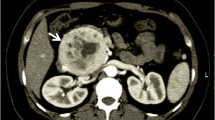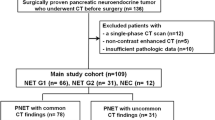Abstract
Purpose
To investigate the correlation between multiple detector computed tomography (MDCT) features of pancreatic neuroendocrine tumors (pNETs) and histopathologic grade and find valuable imaging criteria for grade prediction.
Material and methods
MDCT of 61 patients with 65 masses, which pNETs were approved histopathologically, underwent revision retrospectively. Each MDCT was evaluated for various radiologic characteristics. Absolute and relative (R: tumor/pancreas, D: tumor–pancreas) tumor enhancements were calculated in multiple post contrast phases.
Results
61 patients [mean age = 50.70 ± 14.28 y/o and 30(49.2%) were male] were evaluated and classified into 2 groups histopathologically: G1: 32 (49.2%) and G2,3: 33 (50.8%). Significant relationships were observed between histopathologic tumor grade regarding age (p = 0.006), the longest tumor size (p = 0.006), presence of heterogeneity (p < 0.0001), hypodense foci in delayed phase (p = 0.004), lobulation (p = 0.002), vascular encasement (p < 0.0001), adjacent organ invasion (p = 0.01), presence (p < 0.0001) and number (0.02) of liver metastases, presence of lymphadenopathy with short axis of more than 10 mm (LAP) (p = 0.008), pathologic lymph node size (p = 0.004), relative (R and D) (p = 0.05 and 0.02, respectively), and percentage of arterial hyper-enhancing area (p = <0.0001). Tumor grades, however, had no significant relationship with gender, tumor location, tumor outline, calcification, cystic change, or pancreatic (PD) or biliary duct (BD) dilation (p = 0.21, 0.60, 0.05, 0.05 1, 0.10, and 0.51, respectively). Then, we suggested a novel imaging criteria consisting of six parameters (tumor size > 33 mm, relative (R) tumor enhancement in arterial phase ≤ 1.33, relative (D) tumor enhancement in arterial phase ≤ 16.5, percentage of arterial hyper-enhancing area ≤ 75%, vascular encasement, and lobulation), which specificity and accuracy of combination of all findings (6/6) for predicting G2,3 were 100% and 70.1%, respectively. The highest accuracy (84.21%) was seen in combinations of at least 4 of 6 findings, with 80.00% sensitivity, 87.5% specificity, 83.33% PPV, and 84.85% NPV.
Conclusion
We suggested reliable imaging criteria with high specificity and accuracy for predicting the histopathologic grade of pNETs.



Similar content being viewed by others

References
Belousova E, Karmazanovsky G, Kriger A, Kalinin D, Mannelli L, Glotov A, et al. Contrast-enhanced MDCT in patients with pancreatic neuroendocrine tumours: correlation with histological findings and diagnostic performance in differentiation between tumour grades. Clin Radiol [Internet]. 2017 Feb [cited 2019 May 20];72(2):150. Available from: http://www.ncbi.nlm.nih.gov/pubmed/27890421
Paiella S, Impellizzeri H, Zanolin E, Marchegiani G, Miotto M, Malpaga A, et al. Comparison of imaging-based and pathological dimensions in pancreatic neuroendocrine tumors. World J Gastroenterol [Internet]. 2017 May 7 [cited 2019 May 23];23(17):3092–8. Available from: http://www.ncbi.nlm.nih.gov/pubmed/28533666
Choi TW, Kim JH, Yu MH, Park SJ, Han JK. Pancreatic neuroendocrine tumor: prediction of the tumor grade using CT findings and computerized texture analysis. Acta radiol [Internet]. 2018 Apr 2 [cited 2019 May 23];59(4):383–92. Available from: http://www.ncbi.nlm.nih.gov/pubmed/28766979
Luo Y, Dong Z, Chen J, Chan T, Lin Y, Chen M, et al. Pancreatic neuroendocrine tumours: correlation between MSCT features and pathological classification. Eur Radiol [Internet]. 2014 Nov 22 [cited 2019 May 20];24(11):2945–52. Available from: http://link.springer.com/10.1007/s00330-014-3317-4
Kim DW, Kim HJ, Kim KW, Byun JH, Song KB, Kim JH, et al. Neuroendocrine neoplasms of the pancreas at dynamic enhanced CT: comparison between grade 3 neuroendocrine carcinoma and grade 1/2 neuroendocrine tumour. Eur Radiol [Internet]. 2015 May 3 [cited 2019 May 20];25(5):1375–83. Available from: http://link.springer.com/10.1007/s00330-014-3532-z
Hyodo R, Suzuki K, Ogawa H, Komada T, Naganawa S. imaging findings and pathological grading.Pancreaatic neuroendocrine tumors containing areas of iso- or hypoattenuation in dynamic contrast-enhanced computed tomography: Spectrum of. Eur J Radiol [Internet]. 2015 Nov [cited 2019 May 20];84(11):2103–9. Available from: http://www.ncbi.nlm.nih.gov/pubmed/26321494
Rodallec M, Vilgrain V, Couvelard A, Rufat P, O’Toole D, Barrau V, et al. Endocrine pancreatic tumours and helical CT: Contrast enhancement is correlated with microvascular density, histoprognostic factors and survival. Pancreatology. 2006;6(1–2):77–85.
d’Assignies G, Couvelard A, Bahrami S, Vullierme M-P, Hammel P, Hentic O, et al. Pancreatic Endocrine Tumors: Tumor Blood Flow Assessed with Perfusion CT Reflects Angiogenesis and Correlates with Prognostic Factors 1. Radiology [Internet]. 2009 Feb [cited 2019 May 20];250(2):407–16. Available from: http://www.ncbi.nlm.nih.gov/pubmed/19095784
Zamboni GA, Ambrosetti MC, Zivelonghi C, Lombardo F, Butturini G, Cingarlini S, et al. Solid non-functioning endocrine tumors of the pancreas: correlating computed tomography and pathology. HPB [Internet]. 2017 Nov [cited 2019 May 23];19(11):986–91. Available from: http://www.ncbi.nlm.nih.gov/pubmed/28784262
WHO Classification of Tumours of the Digestive System. Fourth Edition - WHO - OMS - [Internet]. [cited 2019 Jun 23]. Available from: http://apps.who.int/bookorders/anglais/detart1.jsp?codlan=1&codcol=70&codcch=4003&content=1
Choe J, Kim KW, Kim HJ, Kim DW, Kim KP, Hong SM, et al. What is new in the 2017 world health organization classification and 8th american joint committee on cancer staging system for pancreatic neuroendocrine neoplasms? Vol. 20, Korean Journal of Radiology. Korean Radiological Society; 2019. p. 5–17.
Youden WJ. Index for rating diagnostic tests. Cancer. 1950;3(1):32–5.
Sallinen V, Haglund C, Seppänen H. Outcomes of resected nonfunctional pancreatic neuroendocrine tumors: Do size and symptoms matter? Surg (United States). 2015 Dec 1;158(6):1556–63.
Partelli S, Cirocchi R, Crippa S, Cardinali L, Fendrich V, Bartsch DK, et al. Systematic review of active surveillance versus surgical management of asymptomatic small non-functioning pancreatic neuroendocrine neoplasms. Vol. 104, British Journal of Surgery. John Wiley and Sons Ltd; 2017. p. 34–41.
Rosenberg AM, Friedmann P, Del Rivero J, Libutti SK, Laird AM. Resection versus expectant management of small incidentally discovered nonfunctional pancreatic neuroendocrine tumors. In: Surgery (United States). Mosby Inc.; 2016. p. 302–10.
Worhunsky DJ, Krampitz GW, Poullos PD, Visser BC, Kunz PL, Fisher GA, et al. Pancreatic neuroendocrine tumours: hypoenhancement on arterial phase computed tomography predicts biological aggressiveness. HPB (Oxford) [Internet]. 2014 Apr [cited 2019 May 20];16(4):304–11. Available from: http://www.ncbi.nlm.nih.gov/pubmed/23991643
Gu D, Hu Y, Ding H, Wei J, Chen K, Liu H, et al. CT radiomics may predict the grade of pancreatic neuroendocrine tumors: a multicenter study. Eur Radiol. 2019 Dec 1;29(12):6880–90.
Canellas R, Burk KS, Parakh A, Sahani D V. Prediction of pancreatic neuroendocrine tumor grade based on CT features and texture analysis. Am J Roentgenol. 2018 Feb 1;210(2):341–6.
Takumi K, Fukukura Y, Higashi M, Ideue J, Umanodan T, Hakamada H, et al. Pancreatic neuroendocrine tumors: Correlation between the contrast-enhanced computed tomography features and the pathological tumor grade. Eur J Radiol [Internet]. 2015 Aug [cited 2019 May 20];84(8):1436–43. Available from: http://www.ncbi.nlm.nih.gov/pubmed/26022520
Acknowledgements
The authors are thankful to the patients and Imam Khomeini hospital staff for their collaboration.
Author information
Authors and Affiliations
Corresponding author
Ethics declarations
Conflict of interest
The authors of this manuscript declare conflicts of interest.
Additional information
Publisher's Note
Springer Nature remains neutral with regard to jurisdictional claims in published maps and institutional affiliations.
Rights and permissions
About this article
Cite this article
Salahshour, F., Mehrabinejad, MM., Zare Dehnavi, A. et al. Pancreatic neuroendocrine tumors (pNETs): the predictive value of MDCT characteristics in the differentiation of histopathological grades. Abdom Radiol 45, 3155–3162 (2020). https://doi.org/10.1007/s00261-019-02372-x
Published:
Issue Date:
DOI: https://doi.org/10.1007/s00261-019-02372-x



